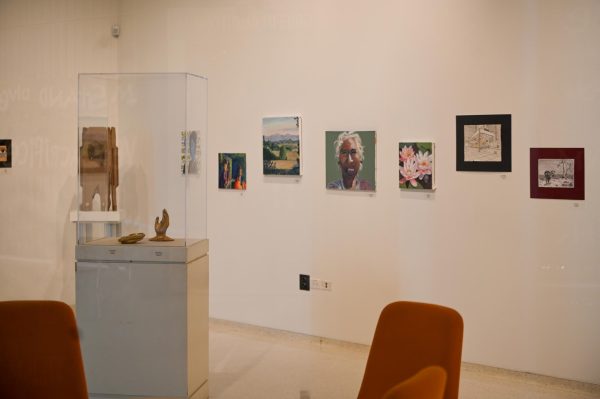At centenary, enjoy unconventional soundscapes of avant-garde composer Iannis Xenakis
Friends of Xenakis / CC BY 2.5
Greek composer Xenakis’s unique music utilizes mathematics and contradicts the stereotype that classical must be calming, light or quaint.
June 8, 2022
“It is an alien shard, glimmering in the heart of the West,” the music critic Ben Watson once observed of the music of the 20th-century avant-garde composer Iannis Xenakis, whose centenary occured May 29. Combining mathematical procedures and a flair for drama, Xenakis was able to create one of the great, sublimely strange sound-worlds in the history of music. In many of his greatest pieces, every measure pulses with an overabundance of density, intricacy and visceral power. His applications of areas of mathematics like game theory and statistics allowed him to compose textures that seem to belong with crashing waves or sprawling swarms of insects. Listeners that brave the wild heart of his creations are rewarded with a sui generis vision of the musical sublime.
Xenakis, a Greek born in Romania in 1922, had an early interest in Greek culture and in mathematics. Although Xenakis fought on behalf of the communists in Greece, he fled his country’s dangerous political climate in 1947, eventually coming to reside in Paris where he worked for the architect Le Corbusier using his recently-acquired knowledge of civil engineering. Xenakis clung to music to justify his own life after leaving his homeland, and, working on music late into the night, his style approached something like a Greek Bartók. Though he was frustrated in his attempts to enroll in formal music education, he met and audited the classes of the French composer Olivier Messiaen, a relationship that provoked Messiean to famously say, “I understood straight away that he was not someone like the others.”
His applications of areas of mathematics like game theory and statistics allowed him to compose textures that seem to belong with crashing waves or sprawling swarms of insects.
— Ryan Clark
While working on a trilogy called “Anastenaria,” Xenakis discovered his mature style during his work on the final piece, the perhaps infamous “Metastaseis” from 1953-54. Almost out of nothing, individual string instruments, each with its own part, commence a glissando. Each glissando traces a slightly different path along a curve, eventually culminating in an enormous “sound mass.” The conductor Hermann Scherchen quickly recognized the achievement of Xenakis’s new score, and as he developed his procedural approaches to musical form and texture, Xenakis was able to make composition his main occupation with paid commissions in the following years.
Not confining himself to simply writing out scores, Xenakis made early efforts to apply computers to music, conceived the UPIC composition program, made pieces of musique concrète, created complex audiovisual “polytope” installations like the “Polytope de Cluny” and wrote a treatise on his approach to composition entitled “Formalized Music.” Ranging from composition with Markov chains to group theory, some of Xenakis’s compositions were subject to tight formal constraints, but despite his almost obsessive production of systems, Xenakis’s use of mathematics almost always works in service of creating new and powerful music.
One of Xenakis’s greatest and most popular orchestral works, the 1977 “Jonchaies” for 107 musicians, shifts through captivating episodes, beginning with an eerie and beautiful canon of glissando string melodies (or “sieves” in his parlance) before moving on to a section of tense, unrelenting rhythm. Xenakis’s three compositions for solo piano and orchestra, “Synaphaï,” “Erikhthon” and “Keqrops,” are altogether some his most effective writing for similarly large orchestral forces. On the smaller scale, Xenakis composed pieces like “Pléïades,” important for the 20th-century percussion repertoire, “Evryali” for solo piano which is based on musical “arborescences” and the comparatively austere “Paille In the Wind” for cello and piano. Those seeking a short introduction to Xenakis’s style should listen to the 1987 “Tracées” for orchestra.
Xenakis died in 2001, and even though the composer still attracts a small dedicated following, one would be hard-pressed to find Xenakis on the program of a major American orchestra. While some celebrations of his centenary have taken or will take place in Europe and Japan this year, America’s orchestras seem to be silent regarding the anniversary of this musical giant. That is a pity.
Xenakis’s music demolishes the stereotypes that classical music must be calming, light or quaint. The affect of his sound-world approaches that of rock or free jazz while remaining in the tradition of classical music. Though the mainstream audiences of today may still not be ready for the full force of his music, Xenakis’s music beckons those eager for a new, electrifying musical horizon; few other composers can rival his mastery in creating works of sheer power and immensity. So, why not give Xenakis a listen for his 100th birthday?


















